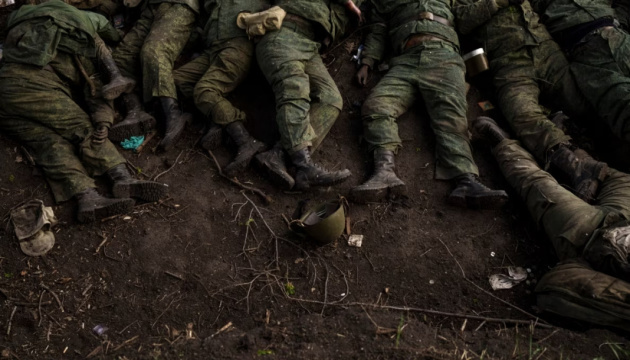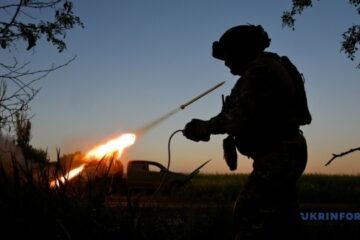Russia has lost more than 1 million troops in Ukraine since the beginning of its full-scale invasion on 24 February 2022, the General Staff of Ukraine’s Armed Forces reported on Thursday.
The figure — which reportedly comes out to 1,000,340 — includes killed, wounded or incapacitated Russian troops.
According to the report, Russia has also lost 10,933 tanks, 22,786 armored fighting vehicles, 51,579 vehicles and fuel tanks, 29,063 artillery systems, 1,413 multiple launch rocket systems, 1,184 air defense systems, 416 airplanes, 337 helicopters, 40,435 drones, 3,337 cruise missiles, 28 ships and boats, and one submarine.
“The overall losses of the Russian occupying forces in manpower since the beginning of the full-scale invasion have reached 1 million,” Ukraine’s General Staff stated. “More than 628,000 occurred in just the past year and a half.”
Releasing the report on Thursday, Ukraine’s General Staff said that the one-million mark is not just a statistic but a symbol of resistance and resilience.
“One million. That’s how much the enemy’s offensive potential has diminished,” the General Staff wrote. “One million who could have destroyed us, but whom we destroyed instead.”
Ukraine started publicly tracking and publishing Russian losses on 1 March 2022, when the count stood at 5,710 killed and 200 captured. Ever since, the losses have been increasing every year.
In 2022, Russia lost 106,720 troops, averaging 340 per day, according to the General Staff of Ukraine’s Armed Forces.
In 2023, the losses more than doubled to an average of 693 per day and 253,290 troops. In 2024, daily losses crossed the 1,000 threshold and totaled at 430,790 troops.
This year, Russia has been losing on average 1,286 troops per day.
Ukraine’s General Staff numbers are in line with intelligence assessments of Ukraine’s western allies.
This fatality rate has surpassed the one the USSR sustained in its war on Finland in 1939-40.
On June 12, 2025, the war crossed another psychologically sensitive milestone: symbolically on Russia National Day, the country’s casualty toll has surpassed one million troops since the beginning of its full-scale invasion on 24 February 2022. And this is a truly huge achievement for Ukraine’s Defense Forces.
More than 1 million Russian casualties, wether killed or wounded, exceed the population of some countries. Moreover, as of January 1, 2025, according to Rosstat, Russia’s national statistics authority, in Russia, there are 16 cities with a population of over 1 million: Krasnoyarsk, Voronezh, Perm, Volgograd, Saratov, Togliatti… Just think about a million Russian soldiers, who will never return to service, living altogether in one of these megacities, it can be argued that it no longer exists – the population of an entire city has been exterminated.
Here is another interesting fact: if we look at the NATO figures (as of October 2022), the Russian Federation has lost almost as many soldiers as there are in the regular armies of 23 Allied armies combined. Namely, we are talking about France (207.1 thousand), Italy (174.8 thousand), Spain (118.2 thousand), Greece (111.4 thousand), Romania (78.5 thousand), Canada (68.2 thousand), Bulgaria (27.4 thousand), Czech Republic (26.9 thousand), Portugal (26.5 thousand), Norway (22.6 thousand), Belgium (22.5 thousand), Hungary (21.4 thousand), Denmark (17.2 thousand), Lithuania (17.2 thousand), Croatia (15.2 thousand), Slovakia (13.8 thousand), Albania (6.6 thousand), North Macedonia (6.2 thousand), Slovenia (5.9 thousand), Estonia (6.9 thousand), Latvia (7.5 thousand), Montenegro (1.7 thousand), and Luxembourg (900) — 1,030,000 troops in total.
Verification of the million: the reality of the figure and its true meaning
We, of course, are more interested in something else – to what extent are the published figures of enemy losses real, and are they not overestimated?
Information from Western partners gives an insight into that question. They have not yet published “fresh” figures, that is, as of June 12. But there is data available for April 3 and May 3, 2025, and this is enough for analysis. In early April, NATO reported that, since the beginning of full-scale invasion of Ukraine, the Russian Federation had lost more than 900,000 soldiers. According to the General Staff of the Armed Forces of Ukraine report dated April 3, 2025, the enemy lost 920,000 troops, killed and wounded. Meanwhile, in May, the UK Ministry of Defense estimated the Russian Federation’s combat losses at approximately 950,000. Again, according to our General Staff (report released on May 3, 2025), Russian losses amounted to 955,000. As we can see, estimates differ, but only marginally, or, as sociologists say, within the statistical error.
Pavlo Lakiychuk, head of military programs at the Center for Global Studies “Strategy XXI”, shares this assessment.
“The difference in estimates by diverse intelligence services of the losses sustained by Russia’s occupying forces in Ukraine is due to varying calculation methods used by analytical units of particular intelligence services. Usually, these are the calculation algorithms tested in multiple military conflicts. But each service uses algorithms of its own. And they are based, accordingly, on different intelligence. However, the fact that different defense departments provide similar absolute figures for losses indicates their objectivity – the Russians have sustained about a million irreversible losses in over three years of the war in Ukraine, which they refer to as Special Military Operation (SVO),” he comments.
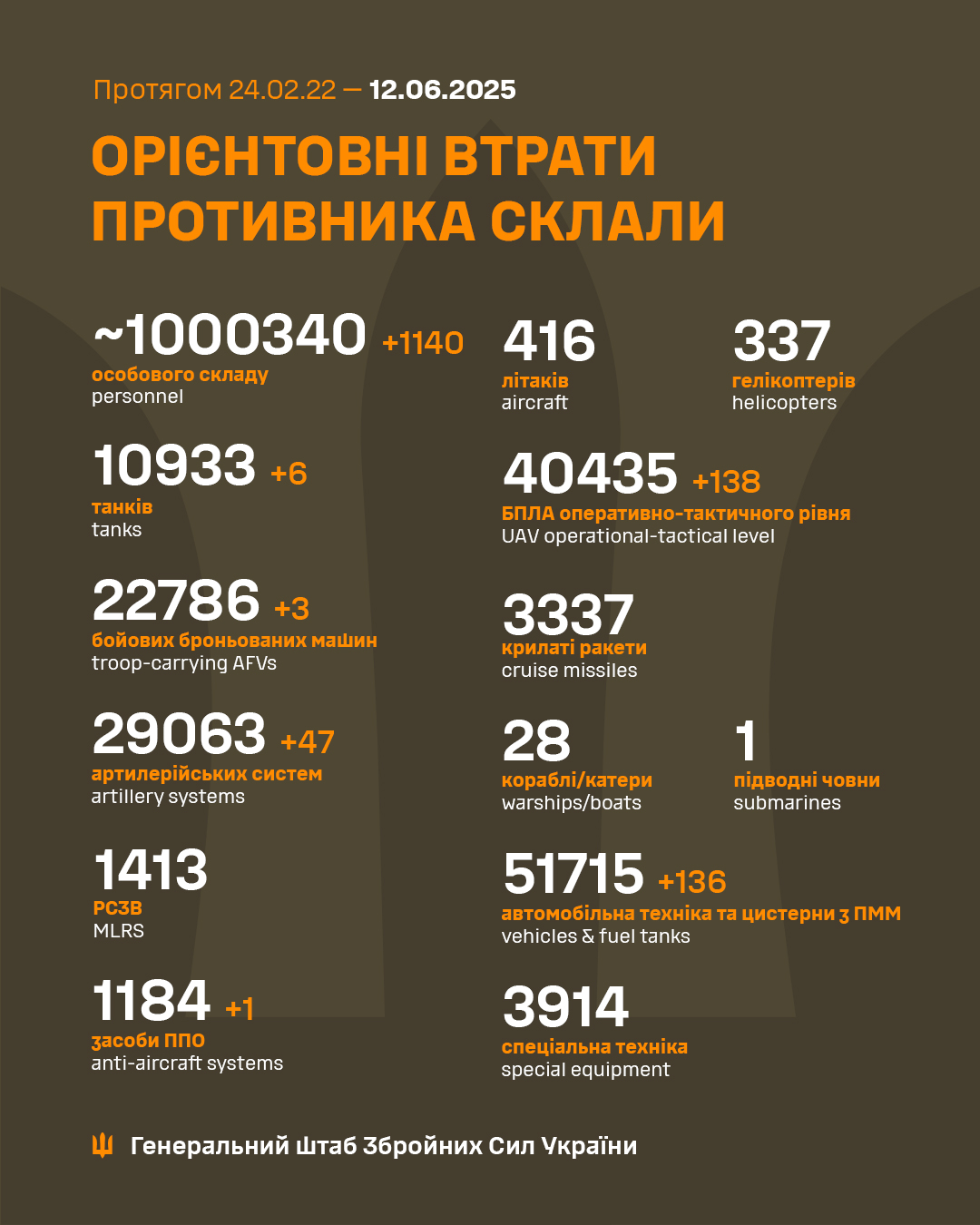
However, the real number of enemy losses may be much higher. According to Kyrylo Sazonov, political scientist, blogger and serviceman from the 41st Special Forces Brigade of the Armed Forces of Ukraine, official statistics include only 100% verified and confirmed cases.
“All data on enemy losses published by the General Staff is 100 percent confirmed information. Each company, battalion, brigade, command staff in each particular direction – everyone submits their reports according to the established procedure, and only after thorough verification do these figures get into the general statistics. If, say, our group goes out on a mission at night, works out against the enemy and returns, I can say, hypothetically: “Yes, we have eliminated 100 occupiers”. But no one will include these words in the report without evidence provided. They will immediately tell me: “Show the video from the drone, provide evidence”. If we can confirm only five – only these five get into the report”, explains Mr. Sazonov.
He emphasizes that it is especially difficult to verify losses after strikes on enemy rear areas. If a drone recorded 20 people present in a barracks building before striking it, only those 20 will be included in the report, even if an estimated 100 people were present there. Thus, the expert argues, official reports are just the tip of the iceberg.
What does this 1 million actually mean? It should be noted that losses in war are divided into irretrievable and sanitary. As experts explain, the Defense Forces’ reports include irretrievable losses only.
“The General Staff of the Armed Forces of Ukraine does not explicitly reveal what it means by “daily enemy losses”. The intelligence services of other countries do not explain this either. However, it is clear that we are talking about irretrievable losses. That is, these are those who will never return to service. Irretrievable losses include those killed, missing, war prisoners, as well as the wounded who died from wounds or sustained disabilities incompatible with further active military service,” Pavlo Lakiychuk explains.
Oleksandr Kovalenko, defense analyst at Information Resistance think tank shares this assessment. He explains: “The classic ratio of those killed to those wounded in war is 1:3 to 1:5. But this figure is variable. It varies depending on the area of hostilities, the intensity of the fighting, whether troops are on the defensive or offensive. … In the hottest directions of the front, such as Pokrovsk direction, for example, the “classics” does not work. The ratio can be 1:1 or even 1:0 – all killed and no wounded.”
So, if we take the classic formula 1 to 3 as basic, then out of a million irretrievable losses, approximately 250 thousand are killed, and 750 thousand are seriously wounded and incapacitated. However, given the intensity of the fighting, the real number of eliminated occupiers may reach 330 thousand (ratio 1 to 2) or even 500 thousand (1 to 1). This makes the current war the most shameful and humiliating for the Russian military, which has already surpassed even the anti-record in losses the Soviet Union sustained in its infamous Winter War against Finland in 1939-1940 (where it lost 422 to 722 thousand killed, wounded, frostbitten and captured).
More explicitly, the losses sustained by the Russian Federation in this war are 5 times as many as in all Russian and Soviet conflicts after World War II, 10 times as many as in the 13-year war in Chechnya, 15 times as many as the Soviet Union lost in its ten-year war in Afghanistan.
Psychological milestone without consequences: why a million losses will not stop Russia
This huge casualty toll, which in any civilized country (the USA, which lost 57,000 troops in Vietnam in 10 years, was shaking from the consequences 40 years later, in the 21st century, – ed.) would cause a political crisis and mass protests, has not yet become a catalyst for change in modern Russia. And the million milestone does not mean either a quick end to the war or the awakening of Russian society.
Oleksandr Kovalenko comments, “At the end of December 2022, the General Staff of the Armed Forces of Ukraine published data on the losses sustained by the Russian military, which by that time had hit 100,000 troops. Then journalists asked me questions: when will Putin stop? Will the Russians themselves stop him? Two and a half years have passed. The situation has not changed. And I answered journalists like this: “Even if a million die, it will not change anything. Because Russian society is amorphous and spineless.” Today we already have a million Russians killed and wounded, but they continue supporting the war of aggression against Ukraine. This does not stop them.” For them, this has turned into just a kind of science – the one called statistics…
According to the expert, this figure demonstrates only one thing: Russia is ready to fight to the last Russian, and society is indifferent to the price of human life. Mr. Kovalenko makes a disappointing conclusion: “What should we do? We should kill even more occupiers. A ratio of losses of 1 to 5 or even 1 to 10 (in our favor) is no longer enough. We must reach rates of 1 to 15, 1 to 20. We have to scale up our ability to eliminate the enemy. Otherwise, the path to victory will be longer still.”
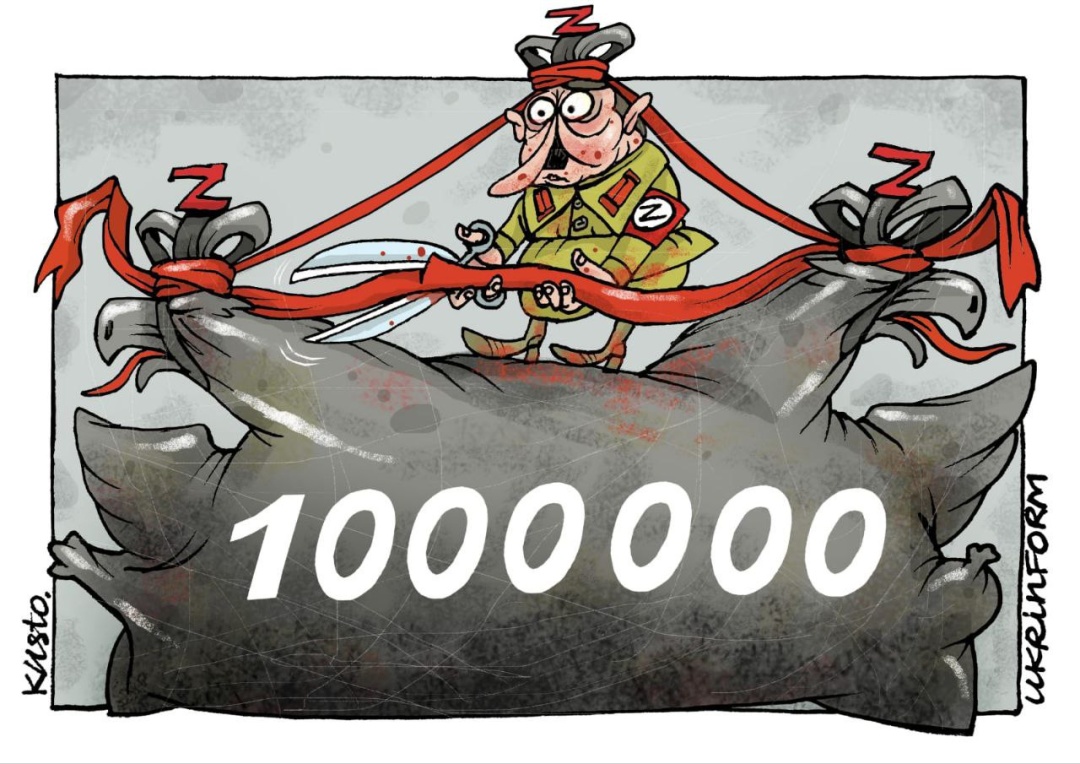
Picture by Oleksiy Kustovsky, exclusive for Ukrinform
At the same time, Kyrylo Sazonov believes that, though that high losses will not stop the aggression immediately, they have a gradual destructive effect.
“This is evidenced by the growth of cemeteries on the territory of the Russian Federation, by the endless flow of corpses in black bags, by the return of tens of thousands of crippled soldiers to Russia. This is gradually destroying the motivation to sign contracts for participation in the so-called SVO. No financial incentives can compensate for the lost lives. And more importantly, we observe how it is becoming increasingly difficult for Russia to recruit more troops: they have to mobilize from everywhere they can, literally, scouring across the world looking for new recruits. So this is an important strategic goal for us. We must make sure that the very word “Ukraine” arouses fear in them at the level of instinct,” the expert emphasizes.
Dmytro Zhmaylo, executive director at the Ukrainian Center for Security and Cooperation, adds specifics regarding the number of Russian citizens killed, referring to open-source data: “Freely available data from Russian obituaries suggests that the Russian Federation has lost 113,681 military personnel killed so far. An important fact is that this figure reflects the number of the killed Russian citizens only, meaning it does not include soldiers recruited from the Donetsk and Luhansk People’s Republics (LDPR) and other mercenaries who were involved in hostilities.” But if we add those who “did not deserve an obituary,” then this figure has to be multiplied by a factor of at least three.
Thus, the million mark is evidence of not only the effectiveness of the Ukrainian Defense Forces, but also of the total degradation of Russian people, who are ready to pay that huge price for the regime’s imperial ambitions.
The enemy’s new tactics: fewer losses with higher intensity of fighting
However, over the past month, there has been a certain fluctuation in the number of enemy’s daily losses. While previously, the average rate stood at 1,300-1,500 occupiers eliminated per day, now the numbers fluctuate around 1,000. And this despite the fact that Putin’s so-called “summer offensive campaign” continues on the front with a high number of clashes. Experts attribute this to a change in the enemy’s tactics.
Oleksandr Kovalenko believes this to be due to the massive use of first-person-view (FPV) drones.
“While in the spring of 2024 they deployed an average of 200-250 FPV drones per day, this has increased to 1,200-1,400 drones deployed on some days. By increasing the number of FPV drones used on the battlefield, the Russians seek to minimize their losses. First, they engage our positions with artillery fire, then deliver pinpoint strikes with FPV drones, and only after that they funnel infantry troops into assaults. It would seem that this light, almost unprotected infantry would supposedly suffer heavy losses. It is thanks to this integrated approach, where enemy positions are engaged multiple times with diverse weapons prior to an infantry assault that the Russians managed to reduce their personnel losses.
The adversary has now shifted its focus towards FPV drones from precision gliding bombs (KABs), which it had until recently used as the main weapon of support for infantry assaults, the expert argues.
Kyrylo Sazonov complements this opinion, describing the situation from a tactical point of view.
“The enemy suffers the greatest losses during major assaults with infantry. An attempt to travel the distance between positions, especially in open terrain, becomes fatal for them. This is actually a no-escape zone, the so-called “kill zone”. This makes the enemy reduce the time they spend in zones of fire exposure. For this, they began using exotic means of transport such as motorcycles, bicycles, electric scooters, buggies, light cars. It seems absurd, but from a military point of view, there is logic behind this: all that means is that a dangerous area be passed through as fast as possible.”
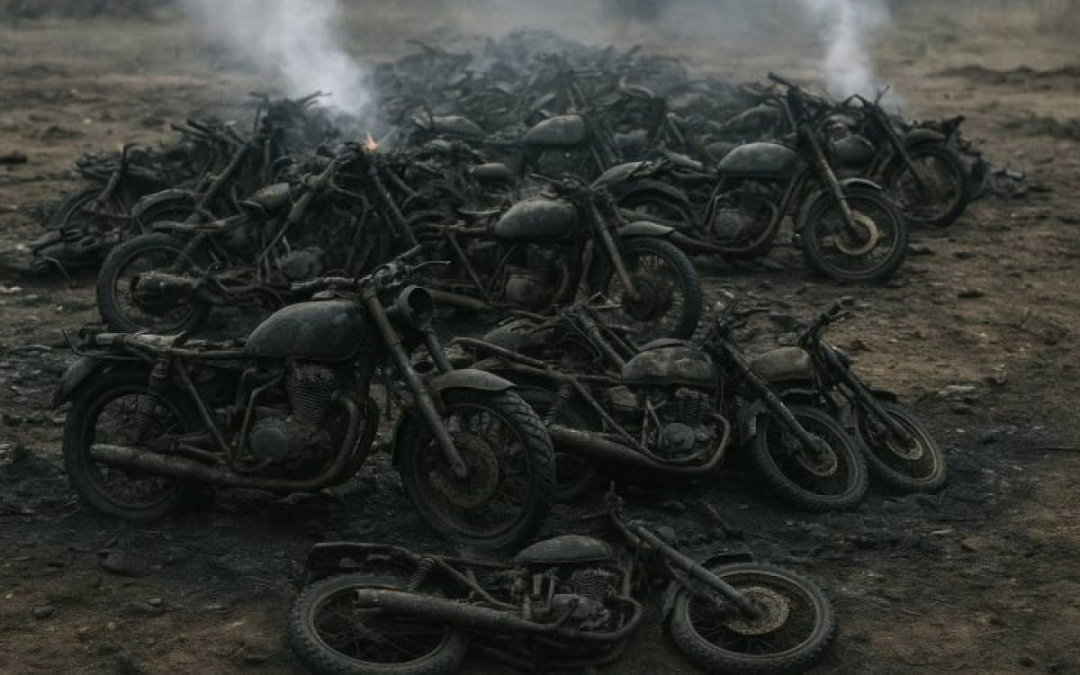
Occupiers try to pass through the kill zone on motorcycles
Mr. Sazonov also notes that the Russians have switched from the tactics of massive “meat grinder” assaults to small-group operations. They are trying to amass forces nearby Ukrainian positions secretly, moving by one or two at a time so as not to become an easy target for artillery. However, he believes that this change in tactics is temporary.
“The situation may change dramatically in the coming weeks – in July or August. The summer campaign has already got underway, but with no obvious results for the enemy. And at some point, in Moscow, the question will definitely be raised: ‘Why is there no breakthrough? Why is the Tsar dissatisfied?’” This, as we have seen more than once, is typically followed by reckless assaults without looking at losses. When the Russians run out of trained assault troops, everyone they can find are thrown into battle – poorly trained infantry soldiers, cooks, clerks. And it is then when we see a sharp increase in losses,” he says.
Dmytro Zhmaylo shares the opinion by the previous expert that the reduction in the number of enemy’s casualties is temporary and does not indicate a general improvement in the situation for the enemy: “The period of a week or two, during which this reduction is actually observed, is not a representative period for drawing conclusions. Despite the fact that the enemy is trying to advance, it does so while conserving forces due to the heavy losses that Ukraine had inflicted previously. Such changes in tactics, caused by limited resources, preclude the possibility of a successful offensive by the force grouping the Russian Federation has accumulated for its summer campaign, meaning the objectives at hand will be impossible to achieve.”
Conclusion notes
The crossing of the threshold of one million irreversible losses is not only a statistical catastrophe for Russia, but also a sentence for its government and society. This figure, verified by multiple different sources, is evidence of both the incredible resilience and professionalism of the Ukrainian Defense Forces and the Kremlin’s blatant disregard for its soldiers.
That said, however, there should be no expectation that this will force the aggressor to stop. On the contrary, the Russian military command demonstrates the ability to adapt by changing tactics to achieve a temporary reduction in the number of casualties through the massive use of drone capabilities and assaulting by small groups. However, this tactical flexibility does not solve the strategic problems facing the occupying army – the depletion of resources and inability to achieve the political goals at hand. Therefore, the expected return to the practice of reckless “meat grinder” assaults is only a matter of time. For Ukraine, this means only one thing: the path to victory lies through further meticulous, technological destruction of the enemy, until the cost of war becomes too high for the Kremlin to bear.
Myroslav Liskovych, Kyiv

